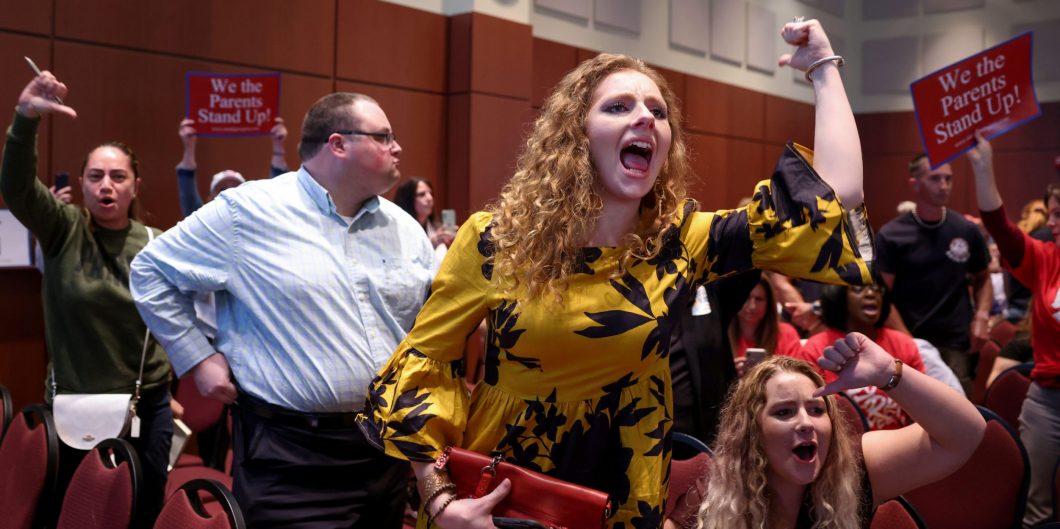Staring Down Fanaticism
My liberal friends would like me to stop talking about “Critical Race Theory.” They tell me that this term is misleading. A quarter-century ago, Critical Race Theory was a branch of legal thought associated with such scholars as Richard Delgado, Kimberlé Crenshaw, and Derrick Bell. Outside the legal profession, nobody had heard of it. Today, the term is mainly used by right-wing figures, as a preamble to sweeping criticisms of liberal politics. I can understand why this feels abusive to people with progressive sympathies. Liberal friends advise me to avoid vague terms and focus on more focused critiques of particular arguments or authors.
That would be a reasonable strategy if Critical Race Theory were still an esoteric legal theory, familiar only to associates of Delgado, Crenshaw, and Bell. Unfortunately, racialized progressive ideologies have expanded far beyond the boundaries of the university lounge. They have crystalized into a fanatical activist movement that seems increasingly bent on reordering our entire society and culture. Moderate liberals still exist, and many are willing to condemn looting, and the extremes of cancel culture, but it is uncomfortable for them to acknowledge the broader threat of progressive fanaticism. For anyone who has found himself in uncomfortable conversations about Critical Race Theory, Curt Jaimungal and Desh Amila’s Better Left Unsaid is a refreshing change of pace. This 2021 documentary shows us what can happen when liberals are prepared to wrestle with the consequences of progressive fanaticism.
Amila, the producer of Better Left Unsaid, is a Sri Lankan-born CEO of an “intellectual touring company” called Think Ink. He stages talks and debates in Australia and New Zealand, and he recently produced a documentary on “Islam and the Future of Tolerance.” Jaimungal, the author and narrator, is a Canadian filmmaker with a background in mathematical physics. He regards himself as a liberal, but over time, he has come to see progressive radicalism as a serious threat. Jaimungal comes across as passionate and a bit geeky. His persona got me thinking about former Google employee James Damore, and also about the bestselling works of Jordan Peterson. He has a similar sense of moral outrage, and that same smarter-than-thou fondness for ornamenting his arguments with discipline-specific jargon. At the granular level, he engages his interlocutors with a laser-like intensity. It’s clear that he means business.
The broader narrative of Better Left Unsaid is, unfortunately, a bit more diffuse. Jaimungal makes brief forays into arguments about tangential subjects: transgenderism, sexism, communism. I was generally sympathetic to the message, but the production would have more impact if it stuck to the film’s central argument in a more disciplined way. This, unfortunately, does not seem to be Jaimungal’s strong suit. He would probably fare well in a college debate round, but he has trouble maintaining his focus beyond the neat logic of the syllogism. It’s an unfortunate weakness, given the complex subject matter, and at times this trained philosopher found herself breaking into patronizing smile: Look how hard he’s trying here! These STEMmy brainiacs are so cute when they delve into heady intellectual subjects!
By the end of the film, though, I had halfway repented of my condescension. Better Left Unsaid may be scatter-shot, but it still covers some philosophically complex points with reasonable clarity. The documentary would be uninteresting if it limited itself to hand-wringing distress over university trigger warnings and loyalty oaths, followed by some triumphalist talk about the power of free speech. Jaimungal goes further, arguing that the left has betrayed its own most cherished principles by accepting a post-modern narrative that treats free speech, inclusion, and even reason itself, as instruments of oppression. This is astute, and very important. If more liberals appreciated the gravity of this problem, there might be some hope for our universities.
Once reason is rejected, it is nearly impossible for any social movement to achieve positive ends. Jaimungal is very aware of this, and he presses the “quo vadis” problem forcefully. Are there any internal constraints on the means progressive radicals are willing to employ? What are their goals, anyway? Can we reasonably expect the left to attain any real goods by revising our history, undermining our institutions, and aggressively silencing anyone who voices an unwelcome opinion?
If progressivism encounters significant resistance from the public, Jaimungal warns, white nationalist movements are likely to expand. Progressives are creating a culture in which ethnic groups are encouraged to assert their collective superiority, insisting that their race entitles them to special privileges. How can it possibly be surprising when some whites decide to make similar arguments on their own behalf? On the other hand, if the left successfully carries Western culture before it, the possibilities might be even uglier. Progressive fundamentalists seem alarmingly impervious to common sense and compromise, and there are notable parallels between today’s critical justice activists and other historical movements that have veered into fanaticism, totalitarianism, and mass murder.
One should think carefully before drawing comparisons of this sort. Ostensibly, Better Left Unsaid is looking to persuade progressives to curb their own radicalism. But people rarely appreciate being put in the same category as Hitler, Stalin, and Mao, and it is generally possible to resist such comparisons, because history is complex, rarely replaying the same script in precisely the same way. Any zealot can protest that he doesn’t hate Jews or Tutsis, or that his little book is green and not red.
Jaimungal goes for the jugular anyway, taking viewers on a tour of murderous political movements from Lenin through the Uighur genocide. Here again, I was skeptical, but by the end of the production I was prepared to acknowledge that the presentation was effective. Partly, it achieves this by being thorough and wide-ranging, hitting both left-wing and right-wing movements, flashing through a grim montage of people murdered en masse for their faith, race, education, or political views. Despite real differences, the similarities are striking. Totalitarians often move from social advocacy on behalf of one group, to the scapegoating of a different group. They generally combine radical social views with the embrace of unchecked state power. No respect is shown for private connections or personal commitments; in the totalitarian mind, these are simply obstacles to be eliminated. Totalitarians often rewrite history to bolster their preferred narrative, and they are happy to cow others into submission by demanding loyalty oaths and insincere expressions of fealty.
Western institutions do not seem healthy at present, and it is difficult to predict what might happen if our political parties are unable to pull themselves into governing shape.
The progressive left does not enjoy totalitarian control of our society. In practical terms, the obstacles to this are (happily) quite significant. But there are alarming similarities between progressive fanatics and the Leninists, Maoists, Khmer Rouge, and Hutus. I would not myself have chosen this argumentative strategy, because I recognize how paranoid and overwrought Jaimungal’s presentation would seem to my moderate liberal friends. Even so, his slideshow of death is genuinely haunting, and I might challenge the skeptical liberal with the following thought. As a Christian, I do sometimes reflect on the mistakes of my believing forebears. I read about Spanish Inquisitors, Constantinople-sacking crusaders, and the early modern wars of religion. I am fascinated by Tudor England, where one family’s religious insecurities drove both Protestants and Catholics to the scaffold, all in the space of a few short years. Is it not reasonable for a religious believer to reflect on these historical episodes? We need to understand what happened in the past, so we can strive to avoid our ancestors’ more damning errors.
Should not conscientious liberals engage in a similar sort of self-evaluation? What precedents might they consider? Since 1900, totalitarian governments have murdered hundreds of millions of people. Their victims were not killed in the name of Jesus. A few despotic figures (such as Francisco Franco or today’s Vladimir Putin) have mixed Christian images into their demagogic rhetoric, but this is exceptional. Communists have generally persecuted and murdered Christians; Nazis accepted their support but assuredly did not salute one another with a pious “Under his eye.” Overwhelmingly, modern democide has been driven by secular ideologies, which can spawn their own terrifying forms of fundamentalism. Godless zealots have committed atrocities far beyond anything the Tudors might have contemplated, and unlike the Spanish Inquisition, these tragedies are not merely historical. Ask the Uighurs.
Do conscientious liberals recognize the gravity of this threat? How much confidence do they have in their ability to self-police, recognizing warning signs as they arise? I think about moderate liberals, scolding me for my use of “Critical Race Theory.” Often, these are people I genuinely like, but I feel no confidence in their ability to forestall catastrophe.
Critical Race Theory may well turn out to be a flash-in-pan phenomenon. Looking back over the past few decades, it is clear that the American left likes to define itself in terms of advocacy on behalf of particular protected groups. After the AIDS crisis, so-called “sexual minorities” became a priority for several years, though September 11 briefly elevated Muslims into the spotlight. Immigrants and lower-wage workers have enjoyed moments of attention, and feminism has had some turns in the drivers’ seat. At the moment, racial justice is the left’s favorite theme. Attention could shift back towards women, though, if Roe v. Wade is overturned. Or, perhaps could a new group take center-stage in the years to come? (Which one? I will not here speculate, but I will just remark that this topic can inspire some lively debates at conservative dinner parties.)
All forms of fanaticism leave their mark on civil society. So far, none have precipitated coups, concentration camps, or summary executions here in America. Canada has also been relatively free of such atrocities. The historical revisionism of Critical Race Theory is more uniquely worrisome, but it still seems fairly likely that this moment too will pass. The fanatics will claim some victories, but eventually the public will become alienated and the movement will falter. A page will turn, and a new chapter will begin. Conscientious liberals like Jaimungal cannot hope to defeat a fanatical movement at the height of its momentum, but they might help to mitigate the damage, while drawing us closer to the next (hopefully saner) epoch.
This seems the most likely outcome. History is full of surprises, however. Western institutions do not seem healthy at present, and it is difficult to predict what might happen if our political parties are unable to pull themselves into governing shape. Will one or another fanatical movement manage to consolidate into an unstoppable juggernaut? Which is likeliest to capture the levers of power?
Better Left Unsaid is not a perfect film, but it is well that Jaimungal did not leave his thoughts unspoken. Many liberals desperately need to look in the mirror. The face looking back might be that of a fanatic.


